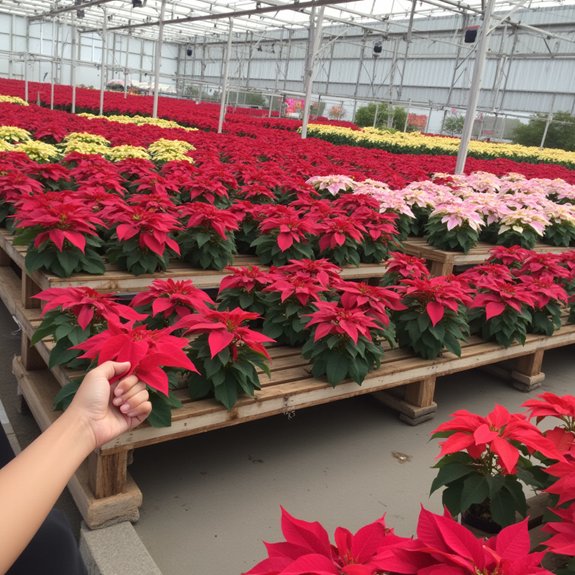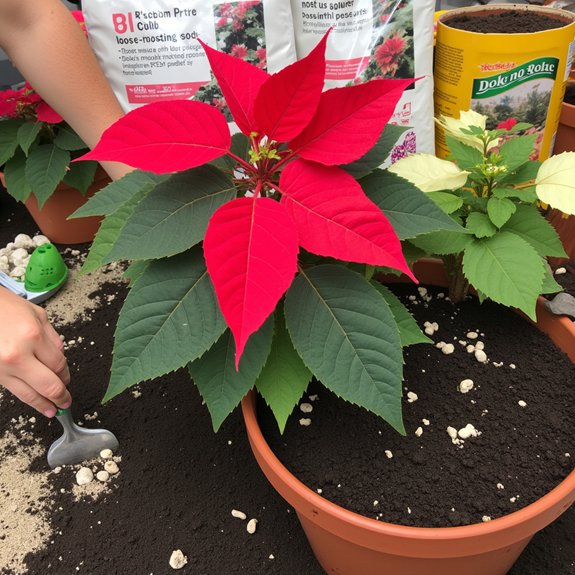You’ll probably be surprised to learn that poinsettias aren’t actually flowers at all—those vibrant red, pink, or white displays are modified leaves called bracts. Most people assume these festive plants are temporary decorations, but you can keep yours thriving year-round with the right care techniques. The secret lies in understanding their unique growth cycle, which requires specific timing for watering, lighting, and seasonal adjustments that’ll transform your holiday centerpiece into a lasting botanical success.
Contents
- 1 Choosing the Perfect Poinsettia: Selection Tips for Long-Lasting Beauty
- 2 Creating the Ideal Environment: Light, Temperature, and Humidity Requirements
- 3 Proper Potting and Soil Preparation for Healthy Growth
- 4 Watering and Fertilizing Schedules Throughout the Year
- 5 Seasonal Maintenance: Pruning, Repotting, and Encouraging Reblooming
- 6 Troubleshooting Common Issues: Pests, Diseases, and Plant Problems
- 7 Safety Considerations and Extending Your Plant’s Display Life
Choosing the Perfect Poinsettia: Selection Tips for Long-Lasting Beauty

While selecting the right poinsettia sets the foundation for weeks of vibrant holiday color, knowing what to look for can mean the difference between a plant that thrives and one that disappoints. Choose plants displayed in warm areas, away from cold drafts. Look for thick green leaves and small yellow cyathia still in bud stage, which guarantees longer-lasting beauty.
Check soil moisture—it should feel damp but not waterlogged. With over 100 poinsettia varieties available, from traditional reds to novelty patterns, you’ll find options beyond the classic Christmas red. This Aztec treasure, with its rich poinsettia history, deserves careful selection for maximum holiday enjoyment.
Creating the Ideal Environment: Light, Temperature, and Humidity Requirements
Once you’ve brought your perfect poinsettia home, setting up the right environment becomes your next priority for maintaining those stunning bracts. Your plant needs bright, indirect light for at least six hours daily. Direct sunlight can scorch the delicate bracts, so position it near a south-facing window with filtered light.
Temperature control is essential—maintain 65-75°F consistently. Avoid cold drafts, heating vents, and chilly windowpanes that’ll stress your plant. Light intensity affects bract color, while humidity levels between 40-60% prevent leaf drop. Use a humidity tray or room humidifier during dry winter months for ideal health.
Proper Potting and Soil Preparation for Healthy Growth

After establishing proper lighting and temperature conditions, your poinsettia’s foundation for thriving depends entirely on correct potting and soil preparation. First, remove that decorative sleeve—it restricts airflow and traps moisture.
Choose a pot size similar to the original container, ensuring adequate drainage holes. Well-drained, slightly alkaline soil types work best for poinsettias. Regular potting mix combined with perlite creates ideal drainage conditions.
When repotting, gently loosen root-bound sections without damaging delicate roots. Position the plant at the same depth as before, then water thoroughly until excess drains from the bottom holes.
Watering and Fertilizing Schedules Throughout the Year
Because poinsettias require different care throughout their seasonal cycles, you’ll need to adjust both watering and fertilizing schedules as the year progresses. During peak blooming season, water only when the top inch of soil feels dry, ensuring proper water quality by using room-temperature tap water. Monthly fertilizing frequency works best during active growth periods from spring through early fall. However, you’ll want to reduce fertilizer use by half during September and October when initiating bract color change. From January to March, as bracts fade, greatly reduce watering but maintain consistent soil moisture levels.
Seasonal Maintenance: Pruning, Repotting, and Encouraging Reblooming

While your poinsettia’s colorful bracts will eventually fade, proper seasonal maintenance can transform this holiday plant into a year-round beauty that’ll bloom again next Christmas. Start pruning techniques in April, cutting stems back to 4-6 inches to encourage fresh growth. Repot in May using well-draining, slightly alkaline soil in a similar-sized container. Throughout summer, pinch back new shoots to promote bushiness. The key reblooming strategies begin mid-September: provide 12-15 hours of complete darkness daily for 8-10 weeks while maintaining regular watering. This darkness triggers bract color development, ensuring spectacular holiday displays for years to come.
Troubleshooting Common Issues: Pests, Diseases, and Plant Problems
Even the healthiest poinsettias can encounter problems, but most issues have straightforward solutions once you identify the culprit. Yellow leaves typically signal watering problems—either too much or too little. Check soil moisture and adjust accordingly. Fungus gnats and spider mites are common pests that thrive in overly moist conditions. Effective pest management includes reducing watering frequency and using insecticidal soap. Brown, shriveled roots indicate root rot, requiring immediate repotting in fresh soil. Disease prevention starts with proper drainage and air circulation. Drooping foliage usually results from temperature fluctuations or inconsistent watering schedules.
Safety Considerations and Extending Your Plant’s Display Life
Despite decades of exaggerated warnings, poinsettias pose minimal risk to your family and pets. Plant toxicity concerns are largely myths—fatal consumption would require eating over 500 leaves. Basic safety precautions include washing hands after handling, as the milky sap may cause minor skin irritation.
To extend your display life beyond the typical 4-6 weeks, maintain consistent temperatures between 65-75°F and avoid cold drafts. Water only when the top inch feels dry, and provide bright, indirect light for six hours daily. With proper care, you’ll enjoy colorful bracts for 6-8 weeks of holiday cheer.
